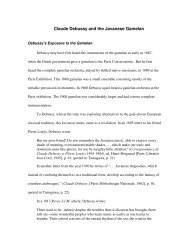Music Preference 1 - Brent Hugh's personal and business web pages
Music Preference 1 - Brent Hugh's personal and business web pages
Music Preference 1 - Brent Hugh's personal and business web pages
You also want an ePaper? Increase the reach of your titles
YUMPU automatically turns print PDFs into web optimized ePapers that Google loves.
<strong>Music</strong> <strong>Preference</strong> 53<br />
correct, audience members whose opinions are not yet set at this age should have a broader<br />
interest in a wider range of musics, a wider range of musical knowledge, <strong>and</strong> perhaps more<br />
accurate knowledge of these musics. They may demonstrate a more refined taste or ability to<br />
make fine musical discriminations, but it may be necessary to follow the development of these<br />
audience members for a further decade or two before the more refined taste <strong>and</strong> fine<br />
discrimination become apparent.<br />
5. The common teaching situations in which the presenter is a music educator (rather than<br />
the performer, as in this study) <strong>and</strong>/or the music is played via recordings (rather than live, as in<br />
this study), could be studied. This research would help isolate to what extent preference<br />
differences are due to (a) simple communication of information <strong>and</strong> knowledge about the<br />
composers <strong>and</strong> music to audience members, giving audience members context for the music they<br />
hear, <strong>and</strong> (b) rapport created between the performer <strong>and</strong> the audience, which may be established<br />
during discussion about the music <strong>and</strong> continued <strong>and</strong> exp<strong>and</strong>ed during the performance of the<br />
music.<br />
6. Different techniques for altering music preference could be studied. For instance, studies<br />
could compare (a) informational presentations via text (program notes), videotape, <strong>and</strong> live<br />
performer, or (b) presentations in which the presenter gives simple information about the music<br />
vs. presentations in which the presenter tries to make the audience feel an emotional association<br />
with the music. These studies, again, could help confirm whether the effect of informational<br />
presentations on music preference is due to information received or to the social <strong>and</strong> emotional<br />
responses evoked.<br />
7. A wider range of recital audiences could be studied. The fact that some age groups have a<br />
different (even a negative) response to spoken introductions to the music suggests that other





